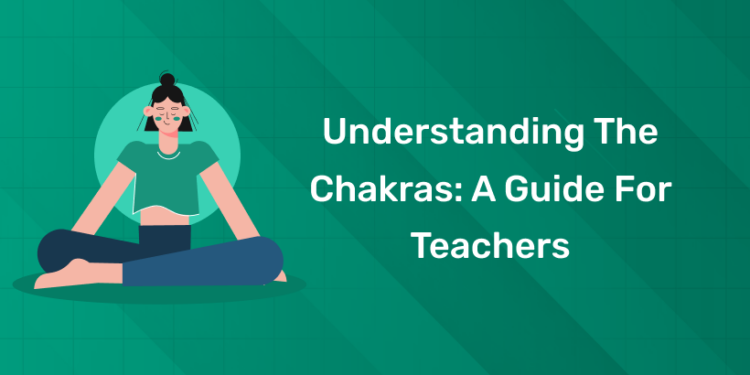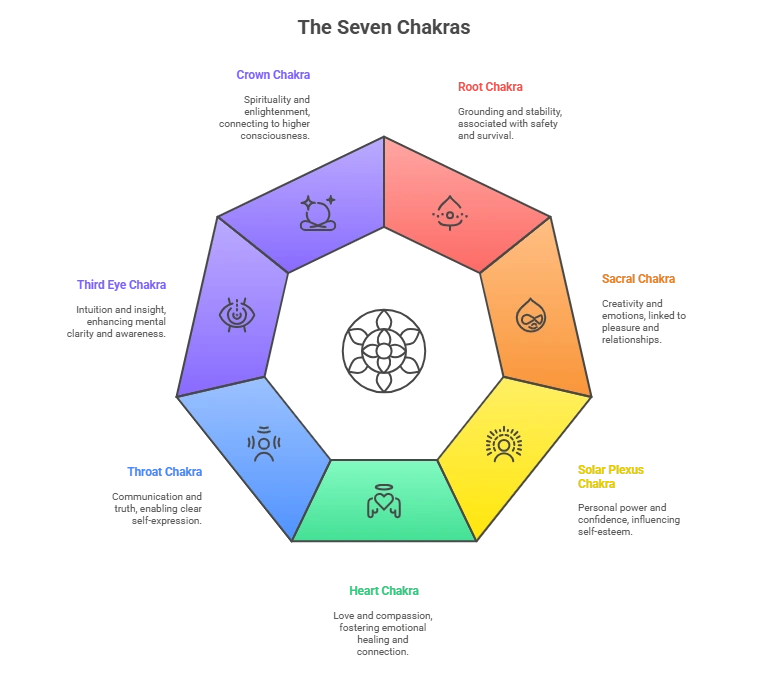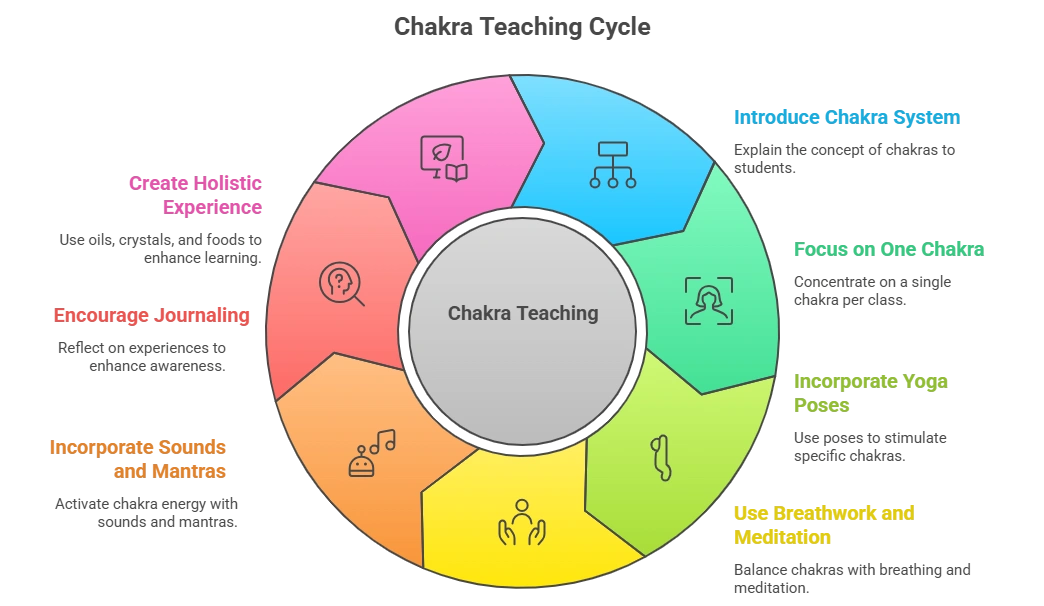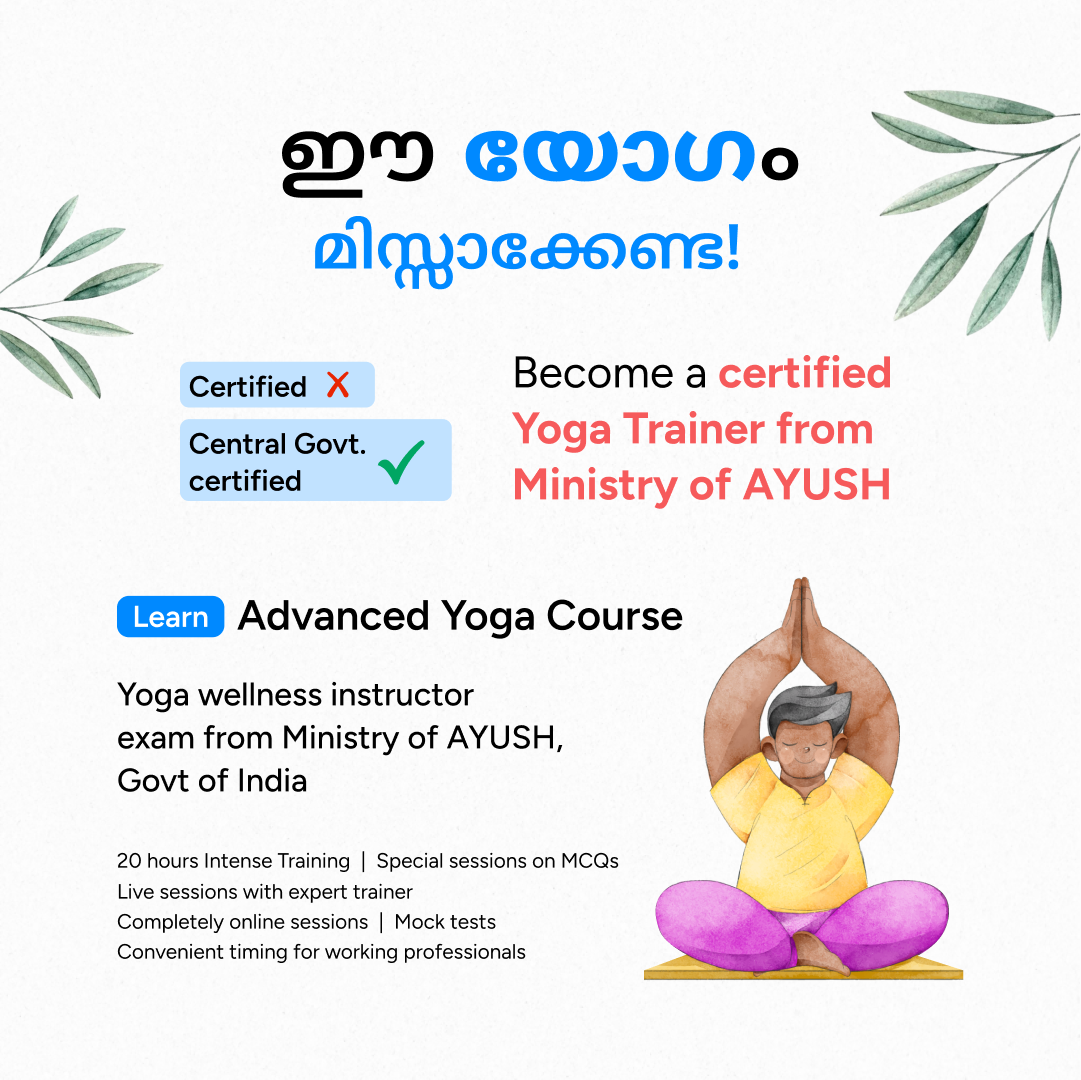Table of Contents
As a teacher, your role goes far beyond textbooks and classrooms; you are shaping the future, nurturing young minds, and creating an environment where learning can thrive. But to do this effectively, you must also take care of yourself, mentally, emotionally, and spiritually. A really good way to accomplish this is to learn about the chakras, or energy centres in the body.
Chakras are not merely a spiritual construct, but rather related to our sense of health, emotional balance, and energy. For teachers who are continually inundated with stress, multitasking, and emotional labor, balancing the chakras can be a transformative experience. It allows one to remain calm, patient, and positive in the classroom.
In this blog, we will discuss what chakras are, how they work, and why having knowledge of them can be especially helpful to teachers. We will also explore these ideas practically, what you can do in your everyday life, and how a practice through programs such as Entri’s Yoga Course can help a teacher empower their inner yoga, and along the way empower their teaching.
Key Takeaways:
- Chakras are energy centers influencing teachers’ emotional, mental, and physical health.
- Chakra awareness helps manage stress, improve communication, creativity, and mindfulness.
- Simple chakra exercises can be integrated into daily teaching routines.
- Teachers equipped with chakra awareness foster healthier classrooms and enhanced learning experiences.
Get Certified, Get Confident! Join Our Yoga Teacher Training Course!
Why Chakras Are Important
Chakras perform an important function in maintaining stability and harmony in our physical, emotional, and spiritual health. It is believed that those power centers that lie along the spine modify the flow of electricity (soul) all through the body. When the cycles are balanced, they sell well and assist save you from emotional and physical barriers. Here are a few motives why chakras are vital:
Energy Flow and Vitality:
The chakras are responsible for handling energy flows in the body. Balanced chakras ensure that energy goes independently, promote vitality, and general health. When one or more chakras are blocked, it is able to cause feelings of lethargy or fatigue.
Emotional Stability:
Each of the chakras correlates with particular emotions and mental processes. For example, Dil Chakra (Anat) is the center of love and compassion, while Solar Playxus Chakra (Manipura) governs self-assurance and personal power. Balanced chakras can provide for emotional stability and can eliminate anxiety, fear, and stress.
Physical Health:
Chakras are associated with exclusive organs and systems inside the body. For example, the neck chakra (easy) is related to neck and conversation, while the root chakra (mulradhara) is attached to the lower back and legs. When a chakra is blocked, it is able to cause bodily soreness or illness in the related area of the body.
Spiritual Growth:
Chakras are important for religious improvement and awakening. For example, the chronchakra (Sahasra) is associated with excessive focus and expertise. By balancing and starting the chakra, people can overcome problems in their spiritual knowledge and relationship with the universe.
Mental Clarity and Focus:
Balanced chakra growth, intellectual readability, attention, and concentration. The third eye cycle (AJNA), which controls instinct and perception, performs an important role in promoting know-how and clean questioning.
The Seven Chakras
Chakras are the energy centers, seven of which are the most critical, that come from Indian culture and philosophy and are important for bodily, emotional, and religious well-being. Each Chakra is associated with specific emotions, organs, colors, and elements that influence specific aspects of our lives. A more detailed discussion of each chakra, including meaning and associated residences, is below:
Teaching Chakras in Yoga Classes
1: Which of these is the primary goal of yoga practice?
Teaching chakra in yoga training is an effective way to difficult at the knowledge of the scholars’ insane connections. Chakras constitute strong facilities inside the body that affect physical, emotional, and non-physical welfare. By integrating chakra coaching into yoga practice, you may help students grow attention, stability, and treatment in life. It is stated right here, the way to learn chakras in your yoga publications:
1. Introduce the Chakra System
Start by explaining the concept of chakras for your students. Describe how these energy centers move with the spine, each of its own different physical, emotional, and spiritual aspects. You can briefly introduce seven chakras, from the root cycle to the top of the head at the bottom of the spine. It helps to create a basis for deep discovery in the classroom.
2. Focus on One Chakra Per Class
Instead of heavy students with all seven cycles at the same time, focus on a chakra per track or a series of classes. For example, if you work with the root cycle, you need to emphasize earthing positions such as Mountain Pose (Tadasana) and Warrior in (Virabhadrasana i), which helps students join stability and power. You can also include intelligence or breathing exercises that match the energy of the cycle.
3. Incorporate Chakra-Specific Yoga Poses
Each cycle is associated with special properties and physical areas of the body. To include poses to include your yoga sequence, active or balance the cycle you focus on. For example, heart collection as a camel position (ostrasana) or bridge position (Setu Bandrasana) can stimulate the heart cycle, promote love and compassion. Encourage students to feel energy flow in these areas as they continue through pose.
4. Use Breathwork and Meditation
Chakra-centered breathing exercises and meditation are powerful tools for balancing and activating cycles. Teach students how to lead different energy centers using pranayama techniques. For example, alternative nostrial breath (heart rate cleaning) can help balance the third eye cycle, increase clarity and intuition. You can also guide the directed attention that focuses on the imagination of the colors and energy of each cycle.
5. Incorporate Sounds and Mantras
Each cycle is attached to specific sounds and Bija mantra (seed sounds) that can help activate its energy. Introduce song or sound treatment in your classrooms. For example, songs of “lamb” can help stimulate the root cycle, while “OM” is associated with the chakra. Using sound helps to elaborate on the relationship between the brain, body, and energy of the students.
6. Encourage Journaling and Reflection
After your class, encourage students to keep a journal or reflect on their experience with the cycle. Ask them to notice any change in their physical sensations, feelings, or mental state. This process of self-fingers helps students to be more aware of energy imbalance and how it addresses them in their practice and daily life.
7. Create a Holistic Learning Experience
Include items beyond asana to learn chakras, such as essential oils, crystals, or foods associated with the color and energy of each cycle. For example, the use of essential oils such as sandalwood under a category focused on the root cycle can increase grounding and stability.
Get Certified, Get Confident! Join Our Yoga Teacher Training Course!
Become a Certified Yoga Instructor
Yoga Teacher Training Course by Entri App: Master authentic yoga techniques, earn certification, and build a successful career as a professional yoga instructor.
Join Now!How Entri’s Yoga Course Helps Teachers with Chakras
Although self-taught is handy, formal training provides richer expertise. Entri’s Yoga Course helps teachers and professionals to grasp yoga, meditation, and chakras in a directed, practical manner.
- With hands-on, expert-led sessions, Entri’s course covers the chakra philosophy and healthy yoga asanas and pranayama for pranic balance.
- Hands-on tools for stress reduction and classroom control
- Step-by-step habits to sync mind and body
By signing up, educators not only improve themselves but also infuse mindfulness and tranquility into their classrooms.
Conclusion
Teaching is both the noblest and most exhausting of professions. To offer the best to students, teachers have to first nurture themselves. Knowledge of the chakras is the secret weapon for teachers wishing to develop emotional resilience, preserve inner equilibrium, and – most importantly – make a difference in the classroom.
With routine and backing from courses such as Entri’s Yoga Course, teachers can find balance in their lives. By aligning body, mind, and spirit, they can not only navigate classroom challenges effectively but also motivate their students to cultivate growth with balance and optimism.
| Related Links | |
| Teaching Yoga Online: Strategies and Best Practices | Yoga and Nutrition: Fueling the Body and Mind |
| The Eight Limbs of Yoga: A Guide for TTC Students | Personality Development at Workplace |
Become a Certified Yoga Instructor
Yoga Teacher Training Course by Entri App: Master authentic yoga techniques, earn certification, and build a successful career as a professional yoga instructor.
Join Now!Frequently Asked Questions
What are chakras, and why are they important in yoga?
Chakras are energy centers in the body that affect physical, emotional and spiritual welfare. In yoga, understanding of cycles helps balance these energies, promotes general harmony and elaborates on the bump connection.
How can I introduce chakras to my yoga students?
Begin by explaining the original concept of chakras and their role in energy flies. You can introduce one cycle per square, explain its significance and include specific yoga position, breathing work or mantras to contact that cycle.
Can chakra-focused yoga help students with emotional or physical issues?
Yes, cycle-centered yoga can help balance emotional stages and address physical imbalance. For example, focusing on the heart cycle can help students fight emotional obstacles, while root cycle work can help anchor and reduce anxiety.
What teaching tools can enhance chakra-focused yoga classes?
Include items such as cycle -specific pose, pranayama (breathing practice), drawn attention, sound treatment, mantra and color, essential oil or crystal to create a multi -sensory experience and to elaborate on the students’ connections for each cycle.
How many chakras are there in the human body?
There are seven main chakras located along the spine, from the root at the base to the crown at the top of the head. Each governs specific aspects of life and well-being.
How can a teacher balance the Heart Chakra?
Simple practices like gratitude meditation, heart-opening yoga poses, and cultivating compassion help balance the Heart Chakra, making teachers more empathetic.
Do chakra practices require advanced yoga knowledge?
Not necessarily. Even basic breathing exercises, affirmations, and simple yoga postures can positively influence chakra balance for beginners.


























